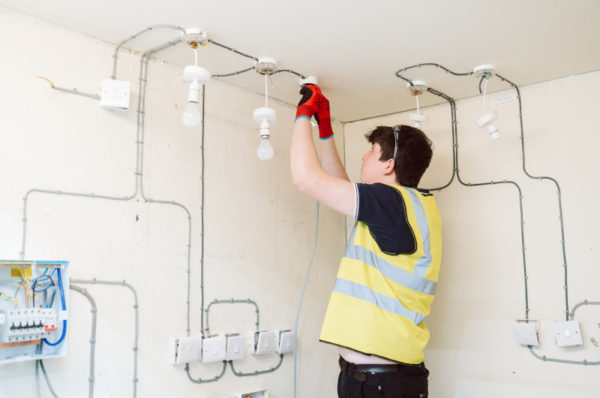Custom-made BRE Electrical Solutions for Efficient and Safe Installations
Custom-made BRE Electrical Solutions for Efficient and Safe Installations
Blog Article
Demystifying Electrical Installation: Understanding Codes and Rules for a Legal and Safe Setup
In the realm of electrical setup, adherence to codes and regulations is extremely important to ensure both legitimacy and safety. The trip to demystifying electrical installation goes beyond simple experience with policies; it requires a profound understanding of how to apply secure electric practices efficiently.
Relevance of Electrical Codes
The adherence to electrical codes is vital in ensuring the safety and security and dependability of electrical setups. Electrical codes serve as a set of criteria and guidelines that determine the correct layout, installment, and upkeep of electrical systems. These codes are developed to lessen the threat of electric dangers, fires, and other security issues that may occur from damaged electric job.

In addition, electrical codes are on a regular basis updated to integrate brand-new technologies, finest techniques, and safety actions. Remaining updated with these codes is essential for specialists in the electric industry to make sure that their work meets the most recent security standards. Ultimately, the importance of electrical codes exists in creating a protected and effective electric framework that benefits both people and neighborhoods.
Secret Laws for Safety And Security
Several basic regulations regulate the safety and security criteria in electrical installations. One key guideline is the National Electric Code (NEC), which offers standards for secure electric style, installation, and inspection to shield people and residential property from electric hazards. The NEC covers elements such as wiring approaches, grounding, overcurrent protection, and equipment installation to make sure a secure electric system.
An additional crucial guideline is the Occupational Safety And Security and Health And Wellness Management (OSHA) criteria, which concentrate on the security of employees included in electrical installations (BRE Services). OSHA policies include requirements for correct training, safety treatments, and personal protective devices to stop work environment mishaps and injuries
Moreover, the International Electrotechnical Compensation (IEC) standards aim to balance electric setup regulations on a worldwide range. These requirements address concerns like electric devices safety, electromagnetic compatibility, and power performance to promote uniformity and security in electric installments worldwide.
Conformity with these key laws is necessary to guarantee the safety and security and legitimacy of electric installments, safeguarding both people and home from the dangers connected with electrical power.
Understanding National Electric Code
Secret policies such as the National Electric Code (NEC) provide essential standards for risk-free electric layout, setup, and evaluation to make certain the protection of people and residential property from electrical dangers. The NEC, additionally called NFPA 70, is a detailed collection of requirements for electric setups that are upgraded every 3 years. It is developed by the National Fire Protection Association (NFPA) and is widely embraced throughout the United States.
The NEC covers different aspects of electrical work, including circuitry approaches, grounding, overcurrent protection, and her response equipment installation. It intends to safeguard individuals and property by attending to potential dangers connected with electrical systems. Compliance with the NEC is usually applied by regional authorities having territory (AHJs), such as building code officials and examiners.
Comprehending the NEC is critical for electric professionals, designers, and examiners to guarantee that setups fulfill the required safety demands. By sticking to the NEC guidelines, specialists can assist protect against electrical mishaps and Web Site guarantee the integrity of electric systems in residential, business, and commercial setups.

Compliance With Neighborhood Building Regulations
Recognizing and adhering to regional building ordinance is essential for guaranteeing the safety and security and conformity of electric installations within a details territory (BRE Electrical Melbourne). Neighborhood building ordinance differ from one municipality to one more, and they are implemented to safeguard the wellness of residents and residential properties. These codes describe specific demands for electrical installations, such as the kind of circuitry to be used, positioning of electrical outlets, basing techniques, and tons capacities. By adhering to neighborhood building ordinance, electrical experts can make certain that installments are done properly and satisfy the essential security requirements.
When it involves electrical setups, failing to adhere to local building regulations can result in significant consequences. Non-compliant setups might posture safety and security threats, enhance the danger of electric fires, and cause expensive penalties or legal issues. In addition, insurer might decline to cover damages arising from installments that do not fulfill local building regulations needs. For that reason, it is critical for electrical experts and contractors to remain informed about and strictly great site stick to the local building ordinance applicable to their projects.
Making Sure Safe Electrical Practices
Practicing stringent adherence to established security methods is vital in the field of electrical installations to reduce prospective risks and ensure the health of people and buildings. Safety in electrical work incorporates numerous elements, beginning with the appropriate training of personnel involved in installment, maintenance, and repair work. By focusing on secure practices, electric installments can operate efficiently while minimizing the chance of accidents or damages.
Conclusion
Finally, adherence to electric codes and policies is important for guaranteeing the safety and security and validity of electrical installments. Comprehending the National Electric Code and compliance with regional building codes are essential for a risk-free setup. By complying with these standards and exercising risk-free electric practices, people can protect against possible risks and make certain the proper functioning of their electric systems.
Report this page